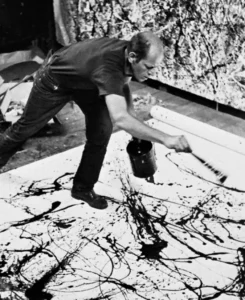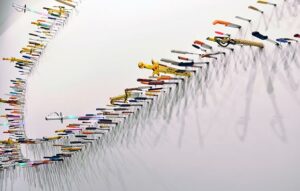Casey Reas’s talk on using code to make generative art with a grip on randomness caught my attention. The whole idea of finding this sweet spot between order and chance in art is super intriguing, especially when you can let randomness guide you a bit without it taking over the whole identity of the piece. This is something that I look forward to incorporating into my IM pieces throughout the semester.
Reas’s example of ‘The Tissue Work,’ inspired by neuroanatomist Valentino Braitenberg, and the controlled randomness they used to simulate conceptual vehicles and patterns over time was mind-blowing. It’s like a dance between structure and surprise. I love the notion of randomness being a “jumping off point” in art – a way to explore possibilities without losing control over the essence of the work.
This example brought several artists to mind, one of them being Farhad Moshiri an Iranian artist known for his intricate yet playful pieces, and I believe his ability to dance on the thin line between intricacy and randomness is what makes his work admirable. Here is an example of one of his pieces:
Another artist that instantly comes to mind is Jackson Pollock, known for his drip painting. As a child, I had a love-hate relationship with this category of artwork because I believed the artist did not deserve the credit for the piece, and that there was not much to it. However, after admiring his work and listening to people’s perspectives I fell in love with the idea of “letting loose” which is exactly what this piece consisted of, allowing gravity and change to create something, with minimal control and high spontaneity. This proposes the question, is the art the final piece or the process of creating it?
 So, I agree with Rea’s idea that embracing randomness in art feels like tapping into a world of creative possibilities. Artists from way back to today are showing us how to walk that fine line between order and chance, making the relationship between art and technology evolve in the most fascinating ways.
So, I agree with Rea’s idea that embracing randomness in art feels like tapping into a world of creative possibilities. Artists from way back to today are showing us how to walk that fine line between order and chance, making the relationship between art and technology evolve in the most fascinating ways.

